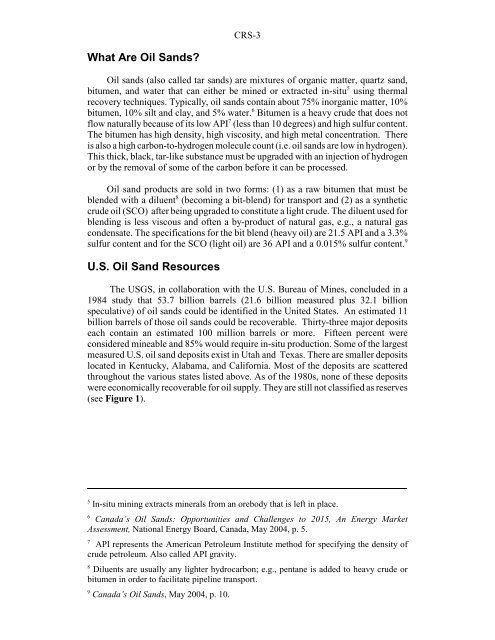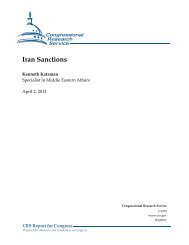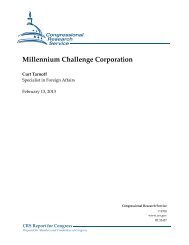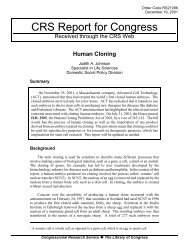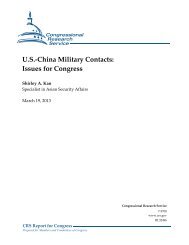North American Oil Sands: History of ... - The Air University
North American Oil Sands: History of ... - The Air University
North American Oil Sands: History of ... - The Air University
Create successful ePaper yourself
Turn your PDF publications into a flip-book with our unique Google optimized e-Paper software.
What Are <strong>Oil</strong> <strong>Sands</strong>?<br />
CRS-3<br />
<strong>Oil</strong> sands (also called tar sands) are mixtures <strong>of</strong> organic matter, quartz sand,<br />
bitumen, and water that can either be mined or extracted in-situ 5 using thermal<br />
recovery techniques. Typically, oil sands contain about 75% inorganic matter, 10%<br />
bitumen, 10% silt and clay, and 5% water. 6 Bitumen is a heavy crude that does not<br />
flow naturally because <strong>of</strong> its low API 7 (less than 10 degrees) and high sulfur content.<br />
<strong>The</strong> bitumen has high density, high viscosity, and high metal concentration. <strong>The</strong>re<br />
is also a high carbon-to-hydrogen molecule count (i.e. oil sands are low in hydrogen).<br />
This thick, black, tar-like substance must be upgraded with an injection <strong>of</strong> hydrogen<br />
or by the removal <strong>of</strong> some <strong>of</strong> the carbon before it can be processed.<br />
<strong>Oil</strong> sand products are sold in two forms: (1) as a raw bitumen that must be<br />
blended with a diluent 8 (becoming a bit-blend) for transport and (2) as a synthetic<br />
crude oil (SCO) after being upgraded to constitute a light crude. <strong>The</strong> diluent used for<br />
blending is less viscous and <strong>of</strong>ten a by-product <strong>of</strong> natural gas, e.g., a natural gas<br />
condensate. <strong>The</strong> specifications for the bit blend (heavy oil) are 21.5 API and a 3.3%<br />
sulfur content and for the SCO (light oil) are 36 API and a 0.015% sulfur content. 9<br />
U.S. <strong>Oil</strong> Sand Resources<br />
<strong>The</strong> USGS, in collaboration with the U.S. Bureau <strong>of</strong> Mines, concluded in a<br />
1984 study that 53.7 billion barrels (21.6 billion measured plus 32.1 billion<br />
speculative) <strong>of</strong> oil sands could be identified in the United States. An estimated 11<br />
billion barrels <strong>of</strong> those oil sands could be recoverable. Thirty-three major deposits<br />
each contain an estimated 100 million barrels or more. Fifteen percent were<br />
considered mineable and 85% would require in-situ production. Some <strong>of</strong> the largest<br />
measured U.S. oil sand deposits exist in Utah and Texas. <strong>The</strong>re are smaller deposits<br />
located in Kentucky, Alabama, and California. Most <strong>of</strong> the deposits are scattered<br />
throughout the various states listed above. As <strong>of</strong> the 1980s, none <strong>of</strong> these deposits<br />
were economically recoverable for oil supply. <strong>The</strong>y are still not classified as reserves<br />
(see Figure 1).<br />
5 In-situ mining extracts minerals from an orebody that is left in place.<br />
6 Canada’s <strong>Oil</strong> <strong>Sands</strong>: Opportunities and Challenges to 2015, An Energy Market<br />
Assessment, National Energy Board, Canada, May 2004, p. 5.<br />
7 API represents the <strong>American</strong> Petroleum Institute method for specifying the density <strong>of</strong><br />
crude petroleum. Also called API gravity.<br />
8 Diluents are usually any lighter hydrocarbon; e.g., pentane is added to heavy crude or<br />
bitumen in order to facilitate pipeline transport.<br />
9 Canada’s <strong>Oil</strong> <strong>Sands</strong>, May 2004, p. 10.


